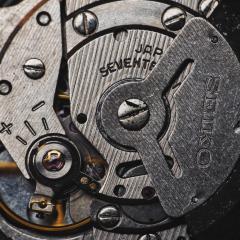-
Similar Content
-
Topics
-
Posts
-
You're thinking metal to jewel in general I guess. Maybe it would be a good idea to peg the pallet jewel hole on the main plate after the epilame treatment. I think that could work as it is my impression that the epilame doesn't sit very hard, but I could be wrong about that so feel free to educate me. I didn't remember that 9501 was thixotropic (thanks for the link). That would mean it's even runnier during impact (lower viscosity) so perhaps it's time I get some fresh grease as mine seems a bit too runny. What I have seen is a whitish surface after washing but it goes away if I scrub the surface with a brush in a degreaser (Horosolv). I don't think it embeds itself in the metal but sticks very hard to the metal. I don't worry too much about the cleaning solution. I just want perfectly clean parts and my solution can be replaced for little money (ELMA RED 1:9). Anyway, I quite often need "to strip back and rebuild" and scrubbing parts by hand isn't exactly the most stimulating part of a service.
-
I’ve had a couple movements where it is clear the previous watchmaker was diligent with lubrication but the old epilam had turned to a fine white powder covering the pallet fork and keyless parts, which can’t be good for parts. I’m spare with epi since I don’t know how long it takes to degrade to that state…
-
By Neverenoughwatches · Posted
I have read some suggestions that it can cause wear , particularly on the fork horns of a fully treated pallet fork. I've had half a kilo of steriac acid powder on a shelf for almost a year now, might have a little play today with a heater and a jar. I think its because it gets into their cleaning solutions Mike. Theirs or anyone else's that services the watch next time, or if they need to strip back and rebuild. Could preclean but thats all time for a pro. I thought the idea was for the epilame to create a barrier, a wall between the lubrication and anything else, so the lube cant spread. -
As I'm only cleaning watches in small numbers at home, I pre-clean any significant deposits of old grease and oil before using the cleaning solutions. I scrape off deposits with pegwood and Rodico, and if really dirty, wash parts in naphtha with a brush. So I'm happy using DX, but can understand why it's avoided by the pros.
-
By Neverenoughwatches · Posted
I think attaching a nut to the lid to pull it off is the least destructive, any damage damage on the outside is going to an easier fix than any created when trying to push it out from the inside. Scratching up the inside of the lid , mainspring or arbor bearing will be risk. Just my opinion.
-










Recommended Posts
Join the conversation
You can post now and register later. If you have an account, sign in now to post with your account.
Note: Your post will require moderator approval before it will be visible.